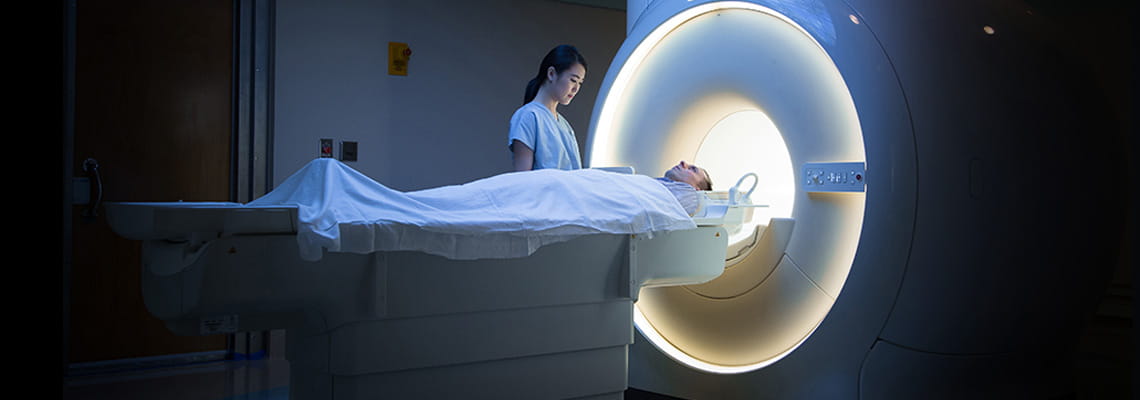Diagnostic Imaging & Radiology
Schedule Imaging
Schedule Your Mammogram

Our Approach to Treatment
Houston Methodist’s board-certified radiologists use the newest imaging technologies to provide patients the most accurate diagnoses, recommend the best possible treatments and administer minimally invasive therapies. We offer 13 convenient imaging locations across the Greater Houston area to serve you near your home or office.Imaging Locations
Our Imaging Services
Computed tomography (CT)
Computed tomography (CT) involves moving an X-ray around a patient to produce multiple detailed images from different angles.
A CT scan provides greater detail of:
- Abdominal and aortic aneurysms
- Blood flow
- Bone injuries and density
- Head, neck and spine injuries
- Heart conditions and diseases
- Internal organs
- Muscle and skeletal disorders
- Oncological imaging
- Transplant imaging
Interventional Radiology
Interventional radiologists use imaging to perform minimally invasive procedures and treatments.
The common interventional procedures performed (and conditions treated) include:
- Arterial interventions
- Body interventions
- Cancer therapies and interventional oncology
- Interventional pain and spine procedures
- Venous access and treatment
- Women's health procedures
Magnetic Resonance Imaging (MRI)
Magnetic resonance imaging (MRI) uses magnets and radio waves to produce images of organs and structures in order to:
- Diagnose heart conditions and strokes
- Assess blood flow and vascular conditions
- Detect tumors and diagnose cancer
- Diagnose breast disease
- Examine reproductive organs
- Diagnose brain, spinal cord, bone and joint conditions and injuries
- Evaluate infections
We offer the best-in-class MRI machines, including wide-bore options.
Mammogram
A mammogram is a breast X-ray that can show small, early stage cancers.
We offer the following screenings:
- 3D screening mammogram
- Diagnostic mammogram
- Bone density scan
A physician order for your screening mammogram is not required.
Nuclear Medicine
Nuclear medicine uses small amounts of radioactive materials to examine organ function and structure.
Positron emission tomography (PET) is a type of nuclear medicine that uses radioactive materials, a special camera and computer to evaluate organ and tissue functions. Tests include:
- Bone scan – diagnoses bone diseases, infections or injuries
- Brain scan – evaluates brain disorders such as Alzheimer’s disease, seizures, tumors and strokes
- Hepatobiliary scan – identifies gallbladder disorders and bile duct obstructions
- Lung ventilation and perfusion scan (VQ scan) – measures air and blood flow in and out of the lungs
- Lymphoscintigraphy – evaluates the lymphatic system and identifies lymph nodes for removal
- Octreoscan – whole-body scans that identify rare neuroendocrine tumors
- Renal scan – evaluates kidney blood flow and function
- Parathyroid scan – identifies abnormal parathyroid glands that cause hyperparathyroidism
- I-131 whole body scan – detects thyroid cancer spread
- Datscan
Ultrasound
Ultrasound uses sound waves to produce images of soft tissues inside the body. Types include:
- Abdominal ultrasound — detects gallstones or tumors
- Aortic duplex exam
- Arteriography and venography —diagnose blood flow abnormalities
- Breast ultrasound
- Carotid ultrasound
- Doppler ultrasound
- Echocardiogram
- Intravascular ultrasound (IVU) — enables radiologists tsee the inner wall of blood vessels
- Musculoskeletal ultrasound — examines joints or muscles
- Obstetrical ultrasound — monitors fetus development
- Pelvic ultrasound — identifies tumors or masses
- Peripheral vascular ultrasound — diagnoses vascular conditions
- Prostate ultrasound — examines nodules
- Renal ultrasound — examines the kidneys and urinary tract
- Scrotal ultrasound — examines the testicles
- Thyroid ultrasound — examines the thyroid
- Transcranial Doppler (TCD)
- Vascular ultrasound
X-Ray
X-ray uses a small dose of radiation to produce images of body structures. Types include:
- Barium X-ray – diagnoses conditions such as tumors, polyps, hernias, strictures, ulcers and other gastrointestinal inflammatory conditions in the GI tract
- Bone density testing – uses X-rays to determine if you have osteoporosis
- Fluoroscopy – studies movement of internal body parts and systems such as blood flow through a blood vessel or food passing through the stomach and intestines
Other Imaging Specialties
We also offer:
- Angiography – uses X-rays and a contrast dye to visualize arteries
- Barium X-ray – diagnoses conditions such as tumors, polyps, hernias, strictures, ulcers and other gastrointestinal inflammatory conditions in the GI tract
- Bone density testing – uses X-rays to determine if you have osteoporosis
- Echocardiogram – also known as a cardiac ultrasound or echo, an echocardiogram uses sound waves to create pictures of your heart
- Fluoroscopy – studies movement of internal body parts and systems such as blood flow through a blood vessel or food passing through the stomach and intestines
- Heart scan – also known as calcium scoring, assesses your risks of developing heart disease and helps a physician anticipate future cardiac events
- Myelogram – uses X-rays (or CT) and a contrast dye to visualize the spinal canal
